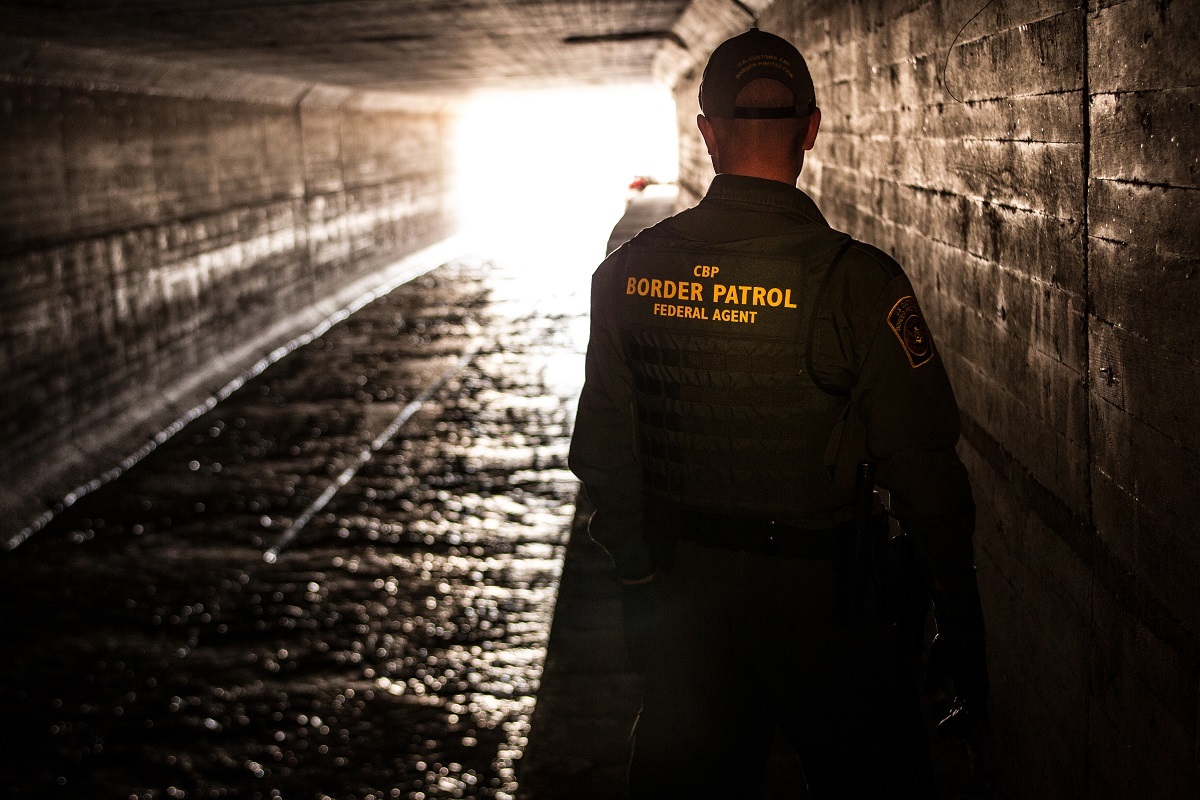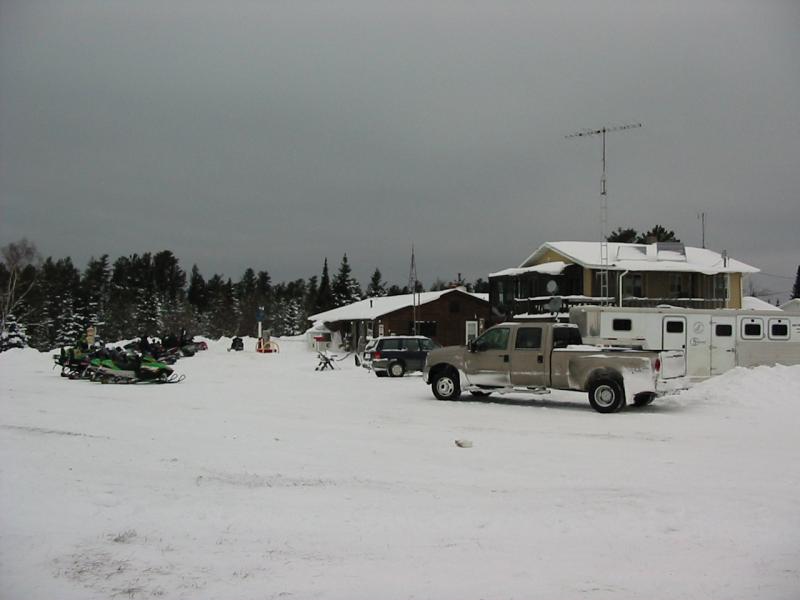Explore the strategies and special equipment used to maintain the integrity of the Nation’s border across a range of challenging environments, from tundra to tunnels.
A Tale of Two-ish Cities 
There is a city in an economically important region. What makes this city unique is that it traverses two countries—that’s to say, an international border cuts this city in two. By virtue of history and culture, these two halves have developed in dramatically different ways. Some of the residents on one side wish to cross into the other, but security measures prevent them from doing so. Nonetheless, both halves constitute one metropolitan area.
This may sound like plight of East and West Berlin during the Cold War; in fact, it’s the story of Nogales, Arizona and Nogales, Sonora, Mexico as it exists today.
18 years ago, Border Patrol Agent Thomas Pittman began investigating the drainage systems in the dank dark beneath Nogales, Arizona. What he expected to see was waste water flowing downstream toward Nogales, Mexico, as both border cities share a limited degree of common infrastructure. What he found instead came flowing in the opposite direction: it was a flood…of people.
At the time, these underground drainage channels had simple gates placed at the point where the United States ceased and Mexico began. Criminals easily broke down these gates, opening up a subterranean highway for illegal immigration and narcotics smuggling.
The U.S. Border Patrol has since replaced these weaker gates with heavy steel ones to disrupt the flow. With passage effectively blocked, those desperate or enterprising enough to attempt an illegal crossing devised a new strategy: tunnel building.
There are generally three types of cross-border tunnels constructed by these criminal networks:
- Rudimentary tunnels are crudely constructed and travel distances less than 20 feet. Unsophisticated, these tunnels do not use shoring, machinery, electrical power or ventilation. Their entrances are usually open air or haphazardly concealed by something as simple as a sheet of plywood.
- Interconnecting tunnels use at least one purpose-built section to break into existing underground infrastructure.
- Sophisticated tunnels are elaborately constructed and may use shoring, ventilation, electricity, railroads or water pumps. These tunnels usually span a long distance. The entrance and exit points of sophisticated tunnels are often located within homes or warehouses. These tunnels, even if they are only open for a short period, can allow traffickers to move massive amounts of drugs, humans, currency, and firearms back-and-forth between Mexico and the United States.
Nogales is the most active illegal tunneling area in the U.S. Through May 2014, 102 of them have been discovered there. And the tunneling problem is a growing one, with tunnel discoveries increasing nationwide in recent years. This boom in illegal tunneling may be due to successful expanded measures by CBP since 2006 to stem the flow of drugs entering the U.S., forcing drug cartels to employ more desperate and intricate measures of their own.
To address this ongoing threat, U.S. Immigration and Customs Enforcement (ICE) Homeland Security Investigations (HSI) established The Nogales Tunnel Task Force in 2011. The task force is made up of personnel from CBP, the Drug Enforcement Administration, and other state and local agencies.
There are several ways the Nogales Tunnel Task Force is combatting the tunnel problem:
Discovery: Members of the U.S. Border Patrol Tunnel Team investigate and examine the way tunnels are constructed and whether they cross the international border. Robots assist with advance entry and clearing of debris to ensure the safety of team members.
Change Detection: Should a makeshift tunnel digger successfully crack into existing infrastructure, they would have unfettered access to the border as well as Nogales. The Tunnel Team explores the labyrinthine underground infrastructure of Nogales for signs of this tampering, chiseling, cracks or other blunt tool marks.
Investigations: Once the tunnel or identified changes to existing subterranean infrastructure is discovered, HSI agents will investigate the source and those responsible.
Sealing the Breach: When a tunnel is discovered, the passage must be thoroughly blocked to prevent trafficking. The type of remediation and materials used depends on the tunnel type and extent of the breach.
Community Partnerships: The Tunnel Task Force engages with members of the community on the surface to help report suspected tunnels or sounds that may be the result of building them.
When it comes to cross-border drug tunnels, “if you hear something, say something.”
DHS Components and Offices Involved
Of Ice and Men 
While much of the area surrounding the southern border is sparsely inhabited scorching hot desert, the area surrounding the northern border could not be more different. By comparison, it seems an idyllic paradise. Take for example the region along the St. Lawrence River separating upstate New York from the Canadian province of Ontario. Along the banks of this river lay all the typical trappings of a classic American summer holiday: countless country clubs, resorts, boating centers and other recreational facilities.
But as summer fun turns to Fall, the several hundred thousand or so sunbathers retreat to their cities and give way to those with more sinister aims. The more frozen the river gets, the more of a hotbed for illegal smuggling it becomes.
This area, known as the Thousand Islands region in northern New York is a geological marvel, as well as a potential menace for Border Patrol agents. 1,864 islands in the St. Lawrence River give the region its namesake. They range in size from more than 40 square miles to small rock piles. The border itself winds seemingly at random between these islands. When winter comes, temperatures drop as low as -40F. Come November, the St. Lawrence is already frozen over with ice so thick it can easily support the weight of a man—and even heavy motor vehicles. This opens up a near infinite number of potential border crossing points for smugglers to exploit.
Some of these ice-bridge crossings—such as those between Wellesley Island (U.S.) and Hill Island (Canada)—are less than the length of a Basketball court across! This geography has made the region an ideal spot for smugglers of illegal products and human traffickers throughout history. During the Prohibition era (1920-1933), smugglers made use of the islands to transport liquor from Canada. After World War II, they were a key entry point for displaced Europeans declared inadmissible into the U.S.
Since then, stemming the tide of smugglers has gotten more sophisticated. The U.S. Border Patrol maintains a station on Wellesley Island, one of the largest and most centrally located of the Thousand Islands. This allows agents to deploy quickly to remote locations, responding to hidden sensor signals or calls from residents regarding suspicious activity.
Even snowmobiling across the frozen bay, seemingly innocuous in the abstract, but in sub-arctic temperatures is cause for concern. What outdoorsman takes a leisurely drive in temperatures that can kill him within minutes? What, then, is his true purpose for being on the river? How close is he to the border? Has he originated from the U.S. or Canada? These are the questions CBP must ask for every vehicle out on the Thousand Islands’ ice.
The area CBP is responsible for keeping a watchful eye over is both inhospitable and immense. Radar and other surveillance methods commonly used to monitor the border are out of the question. Thanks to the topography of the Thousand Islands region, islands and rocks block radar signals, rendering them completely ineffective. Savvy smugglers attempt to capitalize on these limitations, but to no avail.
CBP’s Border Patrol Officers have adapted well to their environment, developing a few killer apps of their own:
Hidden Sensors: Placed throughout the Thousand Islands region, these sensors are tripped when a person or vehicle passes illegally over the border.
Presence Projection: A fleet of snowmobiles and trove of snowshoes let CBP Border Patrol Officers to efficiently cover this vast territory. Snowmobiles allow a law enforcement presence to deploy quickly over large areas to respond to signaling sensors or other signs of illegal entry. Snowshoe patrols let law enforcement quickly traverse areas where the snow is several feet deep, or that is inaccessible to vehicles—places smugglers might mistakenly take for safe havens. Snowshoes also allow Border Patrol Officers to enter remote areas that are otherwise obscured from other methods of observation, and do so quietly without detection.
Clue Spotting: While out on patrol, officers are searching for any sign of disturbance along the border. Unfortunately for smugglers, snow isn’t very forgiving. Footprints and snowmobile tracks are easily spotted. Cut wire signs are also a reliable indicator of illegal entry.
These tactics have proven successful time and again. In one recent instance, CBP Border Patrol agents encountered a lone man walking through the frozen park. He was wearing a snowmobile survival suit--the only reason he hadn't already frozen to death. Curious as the suit was, where he was walking along was also significant: a thin peninsula that constitutes the international border between the U.S. and Canada. Using their unique tracking skills, Border Patrol agents were able to determine precisely the path he had been on. Snowmobile tracks showed that the individual had apparently crossed the frozen St. Lawrence River from Mallorytown, Ontario, Canada, and after a while ditched the vehicle to continue on foot--in sneakers no less. At the Border Patrol station, record checks revealed he had numerous criminal convictions in Canada for drug trafficking, production of a controlled substance, and laundering the proceeds of a crime. This was enough to arrest him for illegal entry into the United States, a crime for which he faces up to two years in prison. He endured the frost to flee to Florida; thanks to CBP's mastery of this unforgiving terrain, he'll now endure prison.
